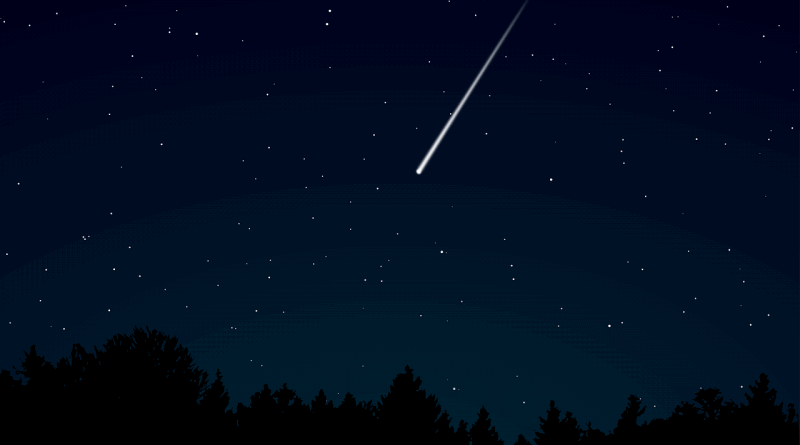Space Is The Place: The Night Sky Over Belper, August 2018
In the Night Sky Over Belper: The Perseids Meteor shower provides the highlight for this month, Mars is very bright, shining red in the southeast. All the major planets are visible but are low in the sky, making telescope observations very difficult – unless you have a clear horizon.
Total Eclipse of the Moon: 27th of July.
It was unfortunate that the clouds rolled in and obscured the Total Lunar Eclipse on the 27th of July. Luckily Total Lunar Eclipses are not as rare as some of the media would have us believe. In the UK the next eclipse will be the 20th / 21st of January 2019 (the total eclipse taking place in the early hours of the morning).
The Perseids Meteor Shower (now – 26th of August).
The Perseids are one of the best meteor showers of the year (the other being the Geminids in December). Formed from the debris left behind by the Great Comet of 1862 (Comet 109P/Swift Tuttle) the Perseids are fast and bright. Some are so bright that they leave glowing trails in their wake.
You can see the Perseids now – just by looking up at the night sky, from about 10.30pm onwards, and by having a bit of patience. However, the best time to see them will be when the shower reaches its peak on the night of August the 12th into the early hours of the 13th (Sunday into Monday). It is also worth watching on the 11th into the early hours of the 12th and on the 13th into the early hours of the 14th – as the peak hourly rate rate will still be high. Viewing will be good on the peak nights as there is little moonlight to spoil the view (let’s hope the clouds stay away). Technically sightings after the peak nights are possible up to the 26th of August, however experience shows that sightings drop off rapidly after the peak nights.
On the peak nights expect to see around one or two meteors every 5 minutes or so. For dedicated meteor watchers the very best time is early in the morning (around 1am – 2am) when the radiant point of the meteor shower is high in the sky. But if you do not want to stay up late decent views can be had from nightfall (around 10.30pm) to midnight.
Any light pollution will spoil your view, so try to get away from street lights if you can. Also try and see as much of the night sky as possible – the wider your field of view the better.
A Note On Satellites.
Whilst looking for Perseids you may also notice that the night sky has many satellites on view.
To spot a satellite look for a “star” that appears to track across the sky. The satellite will appear to be high up and will move smoothly at a constant speed, unlike an aeroplane it will not have flashing or coloured lights and the satellite will pass in silence. A basic rule is aeroplanes blink; satellites don’t.
It is estimated that there are hundreds of satellites visible to the naked eye and thousands more that can be seen with binoculars or telescopes. Most of these are tracked and monitored, both by space agencies and also by enthusiasts. Because they are tracked, satellites are predictable objects. One of the attractions of “sat-spotting” is that it is relatively easy to identify both what is being seen and when it can be seen (for example by using websites and apps like Heavens Above or calsky. More on satellites here: Satellites Are Spinning.
The Planets:
Mars
Mars is spectacular, shining bright and red, rising just after sunset, low in the southeast. Unfortunately Mars is very low in the sky and it is easily obscured by rooftops and the treeline. Look out for it under the Moon on the 23rd of August. Mars’ elliptical orbit is bringing it relatively close to Earth and it should be possible to see its surface details through a telescope; but this is only worth a trying if you have a clear horizon.
Jupiter
Jupiter is visible in the southwest just after sunset. As the month progresses it will start to sink towards the horizon- appearing lower in the sky. On the 17h of August it will be close to the Moon.
A small telescope will show the Galilean moons, Jupiter’s equatorial bands and, maybe, the Great Red Spot (GRS).
Saturn
Saturn is visible in the southern part of the sky, look for it after sunset. Like all the other planets it is low in the sky. On the 20th and the 21st it will be close to the Moon.
Saturn’s position in the sky means that it will be difficult to get a stable image if viewing through a telescope. However, it will still be possible to discern the ring system that surrounds the planet.
Venus
Venus can still be seen low in the west after night fall. It continues to get lower as the month progresses. On the 14th of August, Venus will be close to the Moon and the bright star, Spica.
International Space Station.
There are no sightings of ISS over the next ten days. It is possible to sign up for text and email alerts using the link here: Space Station Alerts. The service only alerts you to good sighting opportunities, that is sightings that are high in the sky and of enough duration to have a chance of spotting the space station. You can also check the Spot the Station site for viewing opportunities later in August.


GDPR, Your Data and Us: https://nailed.community/gdpr-your-data-and-us/